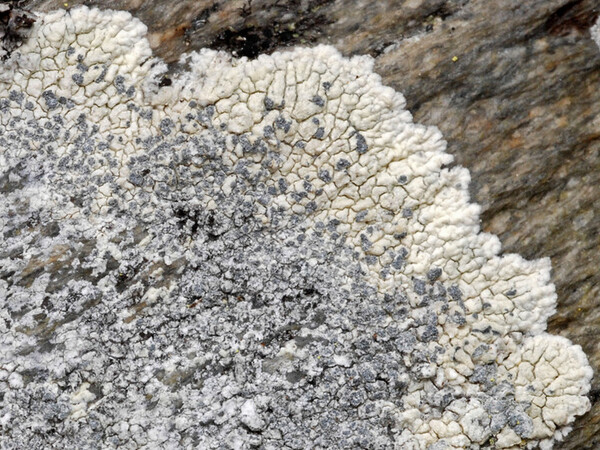Glaucomaria lojkaeana (Szatala) S.Y. Kondr., Lőkös & Farkas
in Kondratyuk & al., Acta Bot. Hung. 61, 1-2: 154, 2019. Basionym: Lecanora lojkaeana Szatala - Ann. Hist. nat. Mus. nat. Hung., ser. nov., 5: 136, 1954.
Synonyms:
Description: Thallus crustose-subplacodioid, episubstratic, rimose to verrucose-areolate, white to yellowish grey, usually pruinose, sorediate, often delimited by a white, more or less arachnoid prothallus, forming up to 2(-3) cm wide, sometimes confluent patches. Areoles flat to convex, thick, ecorticate, with flat to convex, whitish to bluish grey soralia bearing granulose soredia; marginal areoles distinctly elongate, giving the thallus a placodioid appearance. Apothecia very rare, lecanorine, constricted at base to almost stalked, 0.3-1.5 mm across, with a white- or bluish grey-pruinose disc reacting C+ yellow, and a thin thalline margin, without an inner parathecial ring. Epithecium dark grey, densely inspersed with 1-2 µm thick granules reacting C+ yellow; hymenium colourless; paraphyses 1-1.5 µm thick; hypothecium colourless. Asci 8-spored, elongate-clavate, very thin-walled, with a K/I+ blue, tall tholus penetrated by a faintly amyloid apical cushion, the wall K/I-, surrounded by a K/I+ blue outer layer, Lecanora-type. Ascospores 1-celled, hyaline, ellipsoid, 9-14 x 6-7.5 µm. Photobiont chlorococcoid. Spot tests: thallus K+ yellow, C+ yellow-orange, KC+ orange, P+ pale yellow; apothecial disc C+ yellow to orange. Chemistry: atranorin (major), eugenitol (minor), roccellic acid (major), and sordidone (major).
Growth form: Crustose
Substrata: rocks
Photobiont: green algae other than Trentepohlia
Reproductive strategy: mainly asexual, by soredia, or soredia-like structures (e.g. blastidia)
In underhangs rarely wetted by rain
Commonnes-rarity: (info)
Alpine belt: very rare
Subalpine belt: very rare
Montane belt: very rare
Dry submediterranean belt: absent
Humid submediterranean belt: absent
Padanian area: absent
pH of the substrata:
1 2 3 4 5
Solar irradiation:
1 2 3 4 5
Aridity:
1 2 3 4 5
Eutrophication:
1 2 3 4 5
Poleotolerance:
0 1 2 3
Altitudinal distribution:
1 2 3 4 5 6
Rarity
absent
extremely rare
very rare
rare
rather rare
rather common
common
very common
extremely common
Loading data...
Occurrence data
Predictive map
Growth form: Crustose
Substrata: rocks
Photobiont: green algae other than Trentepohlia
Reproductive strategy: mainly asexual, by soredia, or soredia-like structures (e.g. blastidia)
In underhangs rarely wetted by rain
Commonnes-rarity: (info)
Alpine belt: very rare
Subalpine belt: very rare
Montane belt: very rare
Dry submediterranean belt: absent
Humid submediterranean belt: absent
Padanian area: absent
pH of the substrata:
| 1 | 2 | 3 | 4 | 5 |
Solar irradiation:
| 1 | 2 | 3 | 4 | 5 |
Aridity:
| 1 | 2 | 3 | 4 | 5 |
Eutrophication:
| 1 | 2 | 3 | 4 | 5 |
Poleotolerance:
| 0 | 1 | 2 | 3 |
Altitudinal distribution:
| 1 | 2 | 3 | 4 | 5 | 6 |
Rarity
absent
extremely rare
very rare
rare
rather rare
rather common
common
very common
extremely common
Loading data...
Occurrence data
Predictive map








